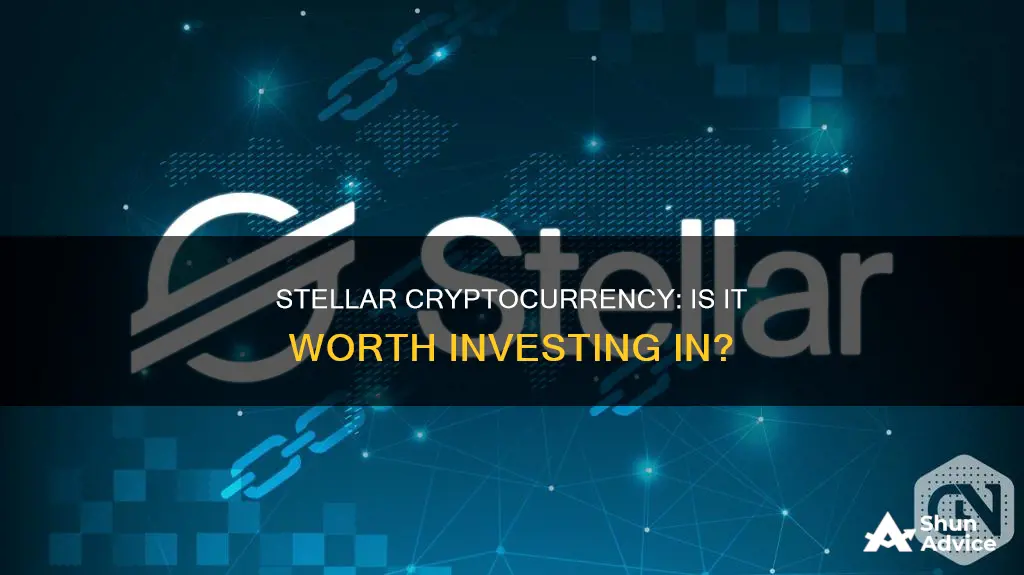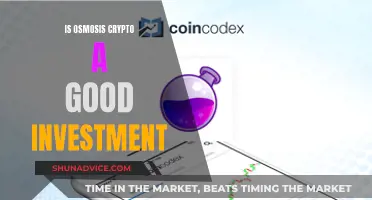
Stellar (XLM) is a decentralised network and cryptocurrency that has gained popularity among investors and even competed with leaders of the digital market. The platform is open to all representations of money and cryptocurrency assets, but it also has its own digital currency called Lumens, or XLM, which is the foundation of the network. Lumens are most often used to pay transaction fees on the Stellar platform, but they also act as the intermediate currency that allows users to execute trades quickly. Stellar is a well-established cryptocurrency project that has been around since 2014 and spent much of that time in the top 50 cryptos by market capitalisation, making it an interesting long-term prospect.
| Characteristics | Values |
|---|---|
| Type of Platform | Decentralized consensus platform |
| Cryptocurrency | Lumen (XLM) |
| Cryptocurrency Exchange | Bittrex, Binance, Poloniex, Kraken |
| Cryptocurrency Wallet | Nano Ledger S |
| Transaction Speed | 5 seconds |
| Transaction Cost | Less than pennies |
| Target User | Average user, especially in developing countries |
| Management Team | Jed McCaleb, David Mazières, Joyce Kim |
| Market Capitalization | $7.5 billion (2021); $4.5 billion (2022) |
| Rank | 18th (2021); 6th (2022) |
What You'll Learn

Stellar's mission and history
Stellar is a blockchain network developed by the Stellar Development Foundation, a non-profit organisation founded by Jed McCaleb. The Stellar Development Foundation supports the Stellar protocol, which is an open-source, decentralised protocol for low-cost digital currency-to-fiat money transfers. This allows for cross-border transactions between any pair of currencies.
The Stellar blockchain's cryptocurrency is called the Lumen, which is traded under the symbol XLM on various cryptocurrency exchanges. The Lumen is designed to be used on the Stellar network to pay transaction and account initialisation fees. The network was created to connect banks, payment systems, and people to facilitate low-cost, cross-border, cross-asset financial transactions.
Stellar was launched in 2014 by Jed McCaleb, founder of Mt. Gox and co-founder of Ripple, alongside former lawyer Joyce Kim. McCaleb formed a website called "Secret Bitcoin Project" seeking alpha testers before the official launch. The Stellar Development Foundation was created in collaboration with Stripe CEO Patrick Collison, and the project received $3 million in seed funding from Stripe. At its launch, the network had 100 billion Stellars, 25% of which were to be given to other non-profits working towards financial inclusion.
Stellar has continued to evolve and expand its partnerships since its launch. In 2015, it released an integration with Vumi, the open-sourced messaging platform of the Praekelt Foundation in South Africa. In the same year, it partnered with cloud-based banking software company Oradian to integrate Stellar into Oradian's banking platform, adding microfinance institutions in Nigeria. In 2016, Deloitte announced its integration with Stellar to build a cross-border payments application, and in 2017, Stellar partnered with IBM and KlickEx to facilitate cross-border transactions in the South Pacific region.
Stellar's primary focus is on developing economies, particularly in the areas of remittances and bank loans to those outside the scope of traditional banking services. It aims to reduce transaction costs and time lags associated with cross-border transactions. As a decentralised, open-source blockchain network, Stellar gives developers the tools to create experiences that are more like cash than crypto, with faster, cheaper, and more energy-efficient transactions.
Stablecoin Investment: A Beginner's Guide to Getting Started
You may want to see also

Advantages over Ripple
Stellar (XLM) and Ripple (XRP) are two prominent players in the digital asset field, both aiming to improve cross-border transactions. While there are many similarities between the two cryptocurrencies, there are some key advantages that Stellar has over Ripple.
Firstly, Stellar has a more decentralized network. It allows anyone to participate as a validator, whereas Ripple operates with a smaller set of trusted validators. This decentralization is particularly useful if the world is moving towards a more decentralized future, which seems to be the trend.
Secondly, Stellar's consensus mechanism is different from Ripple's. Stellar utilizes the Stellar Consensus Protocol (SCP), which enables network participants to reach an agreement on the order of transactions. This mechanism also allows for parallel processing, enhancing scalability. On the other hand, Ripple employs the Ripple Protocol Consensus Algorithm (RPCA), which relies on a network of trusted validators for confirming transactions and ensuring consensus.
Thirdly, Stellar's focus on the average person, particularly those in developing areas of the world, sets it apart from Ripple, which was created specifically to appeal to banks and other financial institutions. Stellar aims to increase the abilities of those in poor or less-developed countries to interact in the global economy with nearly instant and highly affordable transactions.
Additionally, Stellar has its own decentralized exchange (DEX), which allows users to trade crypto-crypto currency pairs. Due to regulatory restrictions, DEXs are one of the only ways American investors can access the lucrative altcoin market.
Lastly, Stellar is not facing the same legal issues as Ripple. The U.S. Securities and Exchange Commission is suing Ripple Labs, alleging the illegal sale of unregistered securities. This has not been the case with Stellar, despite similar coin minting practices, and so Stellar does not face the same regulatory scrutiny and hesitation in adoption.
Overall, Stellar has several advantages over Ripple, including its level of decentralization, consensus mechanism, target audience, decentralized exchange, and lack of legal issues. These factors contribute to its unique network setup and promising partnerships, making it one of the top cryptocurrencies to invest in currently.
Wrapped Bitcoin: A Smart Investment Move?
You may want to see also

The future of Stellar
Stellar is a well-established cryptocurrency project that has been around since 2014. It is a money-transfer platform that aims to help the world's financial systems work together on a single network. Stellar's native cryptocurrency is Lumens (XLM).
Stellar is all about money transfers, and it is designed to make it easy to send money anywhere in the world quickly and cheaply. It is a remittance and money transfer platform, similar to another well-known crypto, Ripple (XRP). However, while Ripple focuses on financial institutions, Stellar is built with the average user in mind, particularly those in developing countries.
Stellar has experienced significant growth over the years. For example, when Mercado Bitcoin announced its use of the platform, Stellar gained almost 3 million user accounts in less than a year. Since then, Stellar has continued to grow, signing on over 55,000 accounts and building partnerships with companies like Coinbase, Franklin Templeton, and MoneyGram.
One of the key advantages of Stellar is its ability to process international payments quickly, efficiently, and at a low cost. Transactions on the Stellar network settle in as little as five seconds and cost just a fraction of what traditional money transfers cost. This makes Stellar ideal for disrupting the traditional banking sector, which often charges hefty fees for cross-border transactions.
- Partnerships and Adoption: Stellar has gained the support of major corporations and financial institutions. For example, it has partnered with companies like MoneyGram, Circle (the company behind USDC), and IBM. Additionally, 30 financial and credit institutions have agreed to cooperate with the blockchain project.
- Functionality and Use Cases: The functionality of Stellar is constantly expanding. Experts predict that XLM will be used to launch an African messenger and facilitate electronic payments in several developed African states. Stellar is also positioning itself as an ideal partner for Central Bank Digital Currency (CBDC) projects, with around 90 countries considering CBDCs, according to the Atlantic Council.
- Technology and Efficiency: Stellar is built on a unique technology that enables fast and efficient currency exchanges. Transactions on the network are confirmed in just five seconds, and users do not lose money on commission costs, paying only a small fee for the service.
- Decentralization and Transparency: Stellar is a fully decentralized system, ensuring that its rate is not susceptible to manipulation by developers and is considered more transparent. The value of coins depends solely on supply and demand in the market. Additionally, the platform uses its own open protocol, making its operations transparent to all users.
- Security and Stability: Stellar employs cryptographic encryption and autonomous nodes to ensure the security of transactions. The network is spread across multiple servers, preventing a single point of failure and ensuring uninterrupted operation.
- Social Impact and Inclusivity: Stellar was created with a mission to help the underbanked in poor and developing countries. It aims to provide access to the global economy through simple, quick, and low-cost transactions.
In conclusion, the future of Stellar looks bright, with its strong fundamentals, growing adoption, and unique features. However, it is important to remember that the cryptocurrency market is highly volatile and subject to various risks. As with any investment, it is crucial to do your own research and carefully consider your financial situation before making any investment decisions.
ENS Coin: A Smart Investment Decision?
You may want to see also

How to buy Stellar
If you're looking to buy Stellar, you'll first need to open an account with a cryptocurrency trading platform that supports it, such as Crypto.com or eToro. These platforms are cryptocurrency exchanges, allowing you to buy and sell digital assets directly on the market.
Once you've chosen a platform, you'll need to open an account and purchase a cold storage wallet to securely hold your coins. A cold storage wallet is a physical device that stores your coins offline using a private key, providing more security than hot storage wallets, which need to be connected to the internet.
After setting up your wallet, you can place a buy order through your brokerage account. This will involve specifying which cryptocurrency you're buying, how many coins, and the desired price. Your broker will then fill the order following your instructions.
Stellar (XLM) is a native cryptocurrency often referred to as "Lumens." The Stellar network is an open-source, blockchain-based distributed ledger designed to store and transfer money across currencies while reducing fees. It aims to connect banks, payment systems, and customers with faster transactions and fewer transfer fees than traditional banking systems.
Stellar has a total supply of around 50 billion, with a circulating supply of roughly half that amount. It is currently the 18th largest cryptocurrency in the world, with a market cap of $7.5 billion.
When considering investing in any cryptocurrency, it is essential to do your research and understand the risks involved.
Harvard's Bitcoin Endowment: Exploring Crypto Investments
You may want to see also

Is it a safe investment?
Stellar (XLM) is a decentralised network that allows users to create, send and trade several types of cryptocurrency. It was created in 2014 by Jed McCaleb, the co-founder of Ripple, with the aim of bringing the world's financial systems together under one network. Stellar is a well-established cryptocurrency project that has been around since 2014 and has spent much of that time in the top 50 cryptos by market capitalisation.
Stellar is a remittance and money transfer platform, designed to make it easy to send money anywhere in the world quickly and cheaply. It is similar to Ripple (XRP) but focuses on individuals rather than financial institutions. Stellar's native cryptocurrency is Lumens (XLM). Lumens are most often used to pay transaction fees on Stellar but also act as the intermediate currency that allows Stellar users to execute trades quickly.
Stellar has experienced several growth spurts, such as when it housed almost 3 million user accounts in less than a year. It has also signed on over 55,000 accounts of its own and built a network of partners that includes Coinbase, Franklin Templeton and MoneyGram.
Stellar has a strong team behind it and solves an important real-world problem – the high costs of making international payments. It has a number of big partnerships, including MoneyGram, Circle (the company behind USDC) and IBM.
However, all cryptocurrency investments are risky, so it is advisable to only invest money you can afford to lose. This is a relatively new and unregulated market with a lot of uncertainty. It is also important to do your research – only you know your risk tolerance, investment priorities and financial situation, so only you can decide if this is the right investment for you.
At the time of writing, Stellar Lumens (XLM) is the 18th largest cryptocurrency in the world, with a market cap of $7.5 billion. Its value has risen from a small fraction of a cent to $0.1087 as of 28 September 2022. While XLM's 59% drop since the beginning of 2022 is alarming, the decline is in line with Bitcoin's and slightly less dramatic than Ethereum's 65% drop. In the context of the larger cryptocurrency market, Lumens' performance suggests the coin could be a viable long-term investment, but it carries significant risk.
Stellar has destroyed half of its Lumens and does not plan to create more, which may cast doubt on its investment potential. However, this also means that the coin will be scarce in the future, and rarity increases the value of any item. The potential increased value could make XLM an excellent asset to buy and hold.
Overall, Stellar is a good crypto to keep an eye on. Its unique network setup, promising partnerships, expansion into decentralised finance, distinct niche compared to XRP, and lack of legal issues make it one of the top cryptocurrencies to buy right now.
Small Bitcoin Investments: Are They Worth Your Money?
You may want to see also
Frequently asked questions
Stellar is a money-transfer platform that aims to help the world's financial systems work together on a single network. It is a decentralised network on which users can create, send and trade several types of cryptocurrency.
Stellar is similar to Ripple (XRP) as the same crypto-pioneer, Jed McCaleb, founded both projects. However, Ripple focuses on financial institutions, while Stellar is designed for individuals, particularly those in developing countries.
As of September 28, 2022, the value of Stellar's native cryptocurrency, Lumens (XLM), was $0.1087.
Stellar has experienced significant growth, with over 55,000 accounts and a network of partners, including Coinbase, Franklin Templeton and MoneyGram. It has strong backing, solves a real-world problem of high international payment costs and has a solid use case.
All cryptocurrency investments are risky. The rise of central bank digital currencies (CBDCs) and stablecoins could undermine the benefits of the Stellar platform. Increased cryptocurrency regulation is also a concern, as the SEC's case against Ripple could have a knock-on effect on other cryptos, including Stellar.







